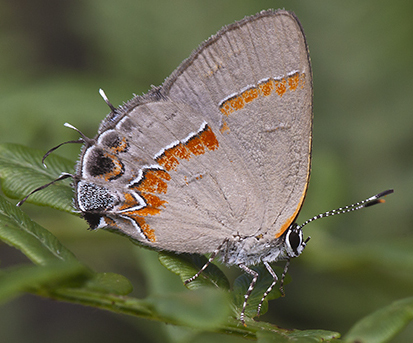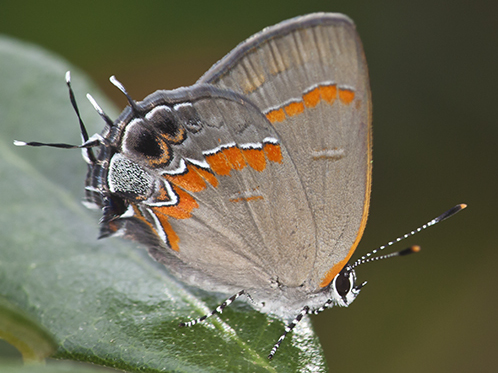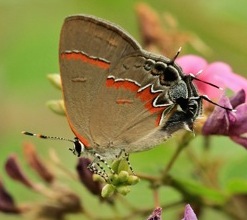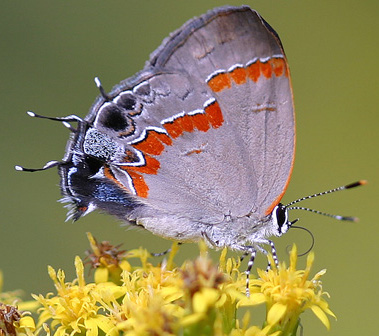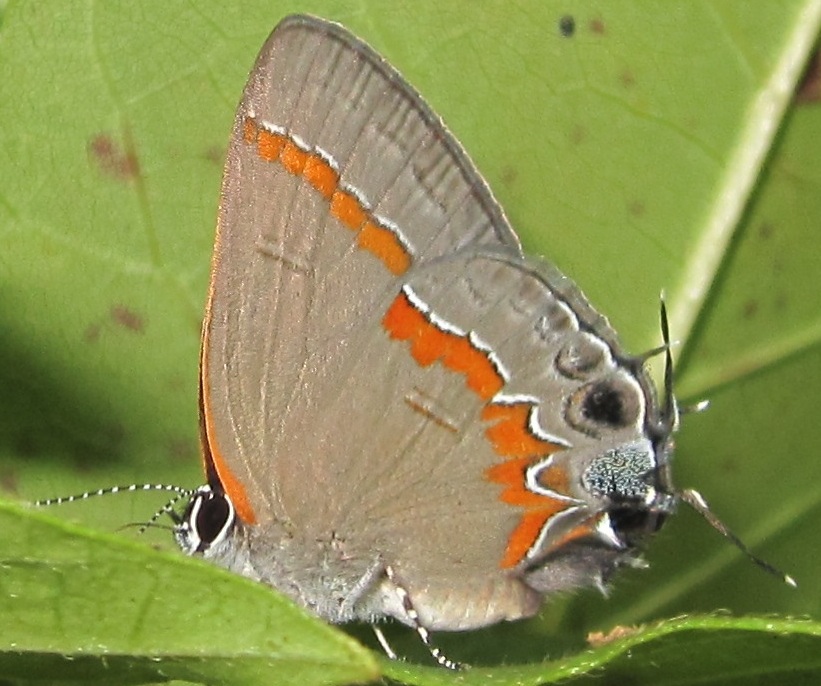|
| Common Name | Red-banded Hairstreak by Roger Rittmaster
[View PDF]
 Click to enlarge Click to enlarge
[Google Images] GBIF [Global Distribution ] BoA [Images ] iNaturalist |
| Scientific Name | Calycopis cecrops
|
| Link to BAMONA species account. |
| Map | Click on a county for list of all database records for the species in that county.
 |
| Distribution | DISTRIBUTION: Statewide; undoubtedly occurring in all 100 counties, but likely absent in the higher Mountains.
|
| Abundance | ABUNDANCE: Common to locally abundant in the lower Coastal Plain; fairly common in the upper Coastal Plain and lower Piedmont, but uncommon in the upper Piedmont and Mountains. At some Coastal Plain sites it is possible to see over 50 in a day; however, in most places fewer than 10 individuals are seen in a day.
|
| Flight | FLIGHT PERIOD: Supposedly two long flight periods. The first brood is from mid- or late March to mid-May in the Coastal Plain and to early or mid-June in the Piedmont. The second brood occurs from early June into late October (sparingly into November) in the Coastal Plain, and from late June to late October in the Piedmont. The Mountain flights are from early April at least to mid-June, and early July to late September. The second flight period is so long -- five months -- that it is conceivable that two broods (without an obvious gap) are present. There is a dip in records in the Coastal Plain in the middle of July that is not seen in the Piedmont; this may be an artifact of poor observation effort in the region at that time of year, rather than a small second brood only from early June to mid-July not seen in the Piedmont. More study of this "quirk" in the flight period is warranted.
|
| Habitat | HABITAT: This species has a wide habitat range in NC. In fact, there is no "typical" habitat, though it favors moist sites close to forested areas. It is most numerous in savannas, pine flatwoods, and swamp margins, but it is found in old fields, woodland borders, weedy lots, powerline clearings, open longleaf pine/oak scrub, pocosin edges, roads through bottomlands, etc. It generally avoids the shade of forests, as well as urban areas, but it occasionally appears in gardens.
|
|
| | Plants | FOOD AND NECTAR PLANTS: The foodplants are mainly fallen leaves of sumacs (Rhus spp.), oaks (Quercus spp.), and waxmyrtles (Morella spp). The species nectars on an extremely wide variety of flowers. In the Coastal Plain, Coastal Sweet-pepperbush (Clethra alnifolia) is a favorite nectar source.
|
| Comments | COMMENTS: This species is considered "common" or "fairly common" more because it is widespread in so many habitats than it is numerous at a single site. For example, I seldom see more than 5 individuals a day, but it occurs in so many habitats in the state that it is a very numerous butterfly in NC. I often encounter them in savannas or forest edges while looking for rare species of skippers or other hairstreaks. I saw more than 50 individuals a day on several occasions in the Dismal Swamp in 1994 and in mainland Dare County in 1997, and one party tallied over 350 in a single day in Carteret County in 2001.
|
State Rank | S5 | | State Status | |
Global Rank | G5 | | Federal Status | |
| Synonym |
|
| Other Name |
|
|
|

 >>
>>